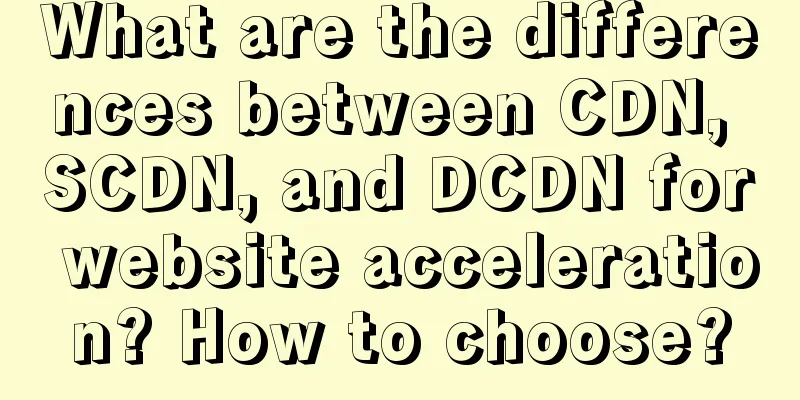What are the differences between CDN, SCDN, and DCDN for website acceleration? How to choose?

|
1. CDN It is the most commonly used acceleration function on the website. Through the distributed server layout, the website business content is cached in cloud servers in various locations for visitors to access nearby. Therefore, websites that use CDN can open very quickly. The limitation is that ordinary CDN acceleration only accelerates static content, such as pictures, documents, etc. 2. SCDN SCDN (Secure Content Delivery Network) is a CDN service with security protection capabilities. While providing stable acceleration, it can also intelligently predict attack behaviors and switch DDoS attack requests to high-defense IPs for cleaning through an intelligent scheduling system. Requests from real users can obtain resources normally from acceleration nodes. The distributed architecture of the acceleration nodes also has the ability to defend against CC attacks, truly achieving a balance between acceleration and security. Traditional CDN acceleration services cannot resist large-scale DDoS and CC attacks. Using high-defense IP alone to protect the source station cannot also take into account acceleration. However, business scenarios such as gaming, finance, government and enterprise security, e-commerce, and medical fields that are vulnerable to attacks but must also take acceleration into account require secure CDN services that have both high defense capabilities and stable and efficient full-link acceleration. Alibaba Cloud SCDN is based on the high-quality edge acceleration resources of Alibaba Cloud CDN and deeply integrates the professional attack and defense strategies of Alibaba Cloud Shield, providing a one-stop overall solution for security and acceleration. You can quickly access Alibaba Cloud SCDN by using the Quick Start Guide. Architecture diagram Intelligently predict attack behaviors and automatically switch malicious requests to high-defense IP addresses without manual operation, achieving data cleansing and protecting the source station. Requests from real users normally obtain resources from the acceleration nodes. Achieve intelligent acceleration and security balance:
Function Anti-DDoS, anti-CC, anti-scam What is the difference between CDN and SCDN? What is the difference between Alibaba Cloud CDN and SCDN? The difference lies in the S. SCDN is a CDN with cloud shield protection function. SCDN is more secure and has more advantages. SCDN function Cloud Shield security protection is injected into edge nodes to take into account acceleration. At the same time, users have exclusive IPs to effectively isolate risks, provide DNS protection, massive DDoS cleaning, anti-CC attack protection capabilities, and all-round 7*24 automated and precise security protection Exclusive IP: Each user and each node enjoys an independent IP, risks are isolated from each other, and business is more secure Intelligent scheduling: fast and automatic scheduling capabilities for daily acceleration/massive attack scenarios, and cleaning of attack traffic at edge nodes. High-performance cache: balanced use of CPU multi-core processing capabilities, efficient and reasonable use and control of memory, and maximization of SSD IOPS and throughput. Ultra-high read and write capabilities: each node has high-speed read and write solid-state drive SSD storage, combined with SSD acceleration capabilities, greatly reducing user access waiting time and improving availability. Flexible custom cache expiration time: custom cache expiration time rules for specified resource content, support for specified paths/test/... or file name suffixes such as *.html. Full-link secure data transmission. Provide enterprise-level reliable HTTPS acceleration services, support custom anti-theft functions, ensure stable online business, and effectively prevent business risks caused by hijacking, tampering, and data leakage. Enterprise-level reliable HTTPS acceleration: Client access, node interconnection, and back-to-source requests all support HTTPS encryption technology. You only need to enable the secure acceleration mode and upload the acceleration domain name certificate/private key. You can view, disable, enable, and edit the certificate. 3. DCDN DCDN is a cloud product with upgraded technology based on CDN acceleration. Intelligently distinguish whether the content being accessed is dynamic or static. If it is static content, Alibaba Cloud CDN can be used to accelerate it directly. For dynamic content, routing decision optimization, protocol optimization, etc. can be used to quickly return to the source to pull content data. Compared with ordinary CDN acceleration that only accelerates static content, such as images and documents, Alibaba Cloud Full-Site Acceleration (DCDN) can intelligently accelerate both dynamic and static content. Please see the table for feature comparison.
Based on the above, among the four cloud products of Alibaba Cloud SLB, CDN, SCDN and DCDN, CDN acceleration is a must for websites, and the other three products are selected on demand. SLB is suitable for medium and large businesses, and is configured with multiple ECS cloud servers and cloud databases for use together; DCDN is a full-site acceleration that can intelligently accelerate dynamic and static content; SCDN is based on CDN acceleration and can defend against large-scale malicious DDoS and CC attacks. The above are the differences between these four products and how to choose, please be aware of them. You may also be interested in:
|
<<: The difference between useEffect and useLayoutEffect in React
>>: MySQL 8.0.17 installation and usage tutorial diagram
Recommend
Example code for implementing dotted border scrolling effect with CSS
We often see a cool effect where the mouse hovers...
MySQL Flush-List and dirty page flushing mechanism
1. Review The Buffer Pool will be initialized aft...
Introduction to Enterprise Production MySQL Optimization
Compared with other large databases such as Oracl...
js canvas realizes random particle effects
This article example shares the specific code of ...
Mysql database master-slave separation example code
introduce Setting up read-write separation for th...
About the basic configuration tutorial of MySQL5.7.17 free installation version under Win10 (with pictures and text)
Database application is an indispensable part of ...
Docker memory monitoring and stress testing methods
The Docker container that has been running shows ...
WEB standard web page structure
Whether it is the background image or the text siz...
How to install and configure WSL on Windows
What is WSL Quoting a passage from Baidu Encyclop...
MySQL not null constraint case explanation
Table of contents Set a not null constraint when ...
Web design and production test questions and reference answers
<br />Web Design and Production Test Part I ...
Use js to write a simple snake game
This article shares the specific code of a simple...
jQuery treeview tree structure application
This article example shares the application code ...
VMware 15.5 version of the graphic tutorial to build a yum warehouse by mounting the system CD
1. Open the CentOS 7 virtual machine. 2. Log in t...
How to use shtml include
By applying it, some public areas of the website c...











